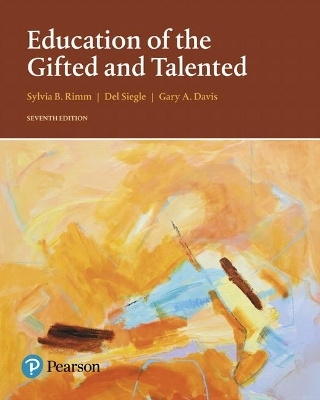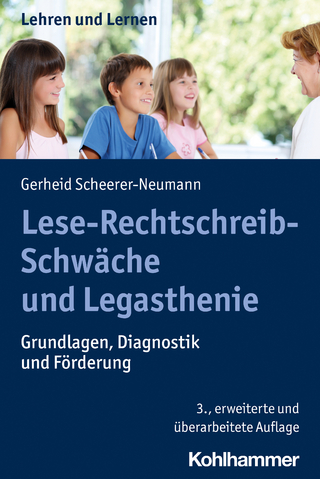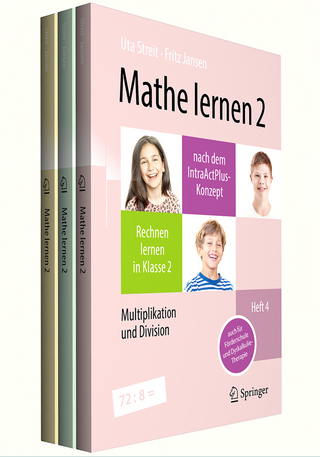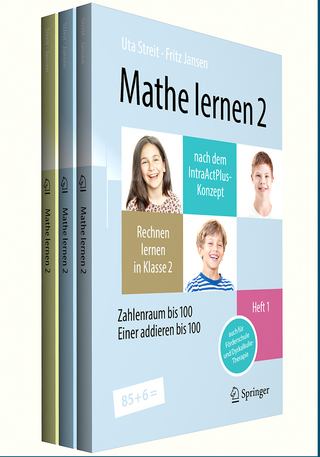
Education of the Gifted and Talented
Pearson (Verlag)
978-0-13-382710-1 (ISBN)
- Titel erscheint in neuer Auflage
- Artikel merken
Dr. Rimm was a longtime contributor to NBC’s Today Show, hosted Family Talk on public radio nationally, and served on the Board of Directors of the National Association for Gifted Children. She has received the prestigious Anne F. Isaacs, Robert Rossmiller and Palmarium awards for her lifetime contributions to gifted children. Del Siegle is a professor in gifted and talented education and Director of the National Center for Research on Gifted Education (NCRGE) at the University of Connecticut. NCRGE is the only federally funded national research center on gifted education. He is a past president of the National Association for Gifted Children (NAGC), past president of the Montana Association of Gifted and Talented Education (Montana AGATE), past chair of the Research on Giftedness, Creativity, and Talent SIG of the American Educational Research Association (AERA), and former Head of the Department of Educational Psychology at the University of Connecticut. Along with D. Betsy McCoach, he was co-editor of Gifted Child Quarterly (GCQ) and the Journal of Advanced Academics (JOAA). He writes a technology column for Gifted Child Today. In addition to being a co-author of Education of the Gifted and Talented, he is also author of The Underachieving Gifted Child: Recognizing, Understanding, and Reversing Underachievement. Prior to becoming a professor, Dr. Siegle worked with gifted and talented students in Montana.
Chapter 1 Gifted Education: Matching Instruction with Needs 1
Chapter 2 Characteristics of Gifted Students 23
Chapter 3 Identifying Gifted and Talented Students 40
Chapter 4 Program Planning 72
Chapter 5 Acceleration 95
Chapter 6 Grouping, Differentiation, and Enrichment 116
Chapter 7 Curriculum Models 142
Chapter 8 Creativity I: The Creative Person, Creative Process, and Creative
Dramatics 163
Chapter 9 Creativity II: Teaching for Creative Growth 177
Chapter 10 Teaching Thinking Skills 197
Chapter 11 Leadership, Affective Learning, and Character Education 221
Chapter 12 Underachievement: Identification and Reversal 235
Chapter 13 Cultural Diversity and Economic Disadvantage: The Invisible Gifted 264
Chapter 14 Gifted Girls, Gifted Boys 289
Chapter 15 Gifted Children with Disabilities 308
Chapter 16 Parenting the Gifted Child 328
Chapter 17 Understanding and Counseling Gifted Students 349
Chapter 18 Program Evaluation 374
Preface v
Chapter 1 Gifted Education: Matching Instruction with Needs 1
History of Giftedness and Gifted Education 3
Contemporary History of Gifted Education 4
National Center for Research on Gifted Education 9
Definitions of Giftedness 11
Explanations and Interpretations of Giftedness and Intelligence 13
Summary 21
Chapter 2 Characteristics of Gifted Students 23
The Terman Studies 23
Traits of Intellectually Gifted Children 26
Affective Characteristics 27
Characteristics of the Creatively Gifted 30
Characteristics of Historically Eminent Persons 31
Characteristics of Teachers of the Gifted 36
Summary 38
Chapter 3 Identifying Gifted and Talented Students 40
Thoughts and Issues in Identification 41
National Report on Identification 44
Identification Methods 44
Assessment of Gardner’s Eight Intelligences 55
Triarchic Abilities Test 55
A Multidimensional Culture-Fair Assessment Strategy 56
Talent Pool Identification Plan: Renzulli 56
Identifying Gifted Preschoolers 57
Identifying Gifted Secondary Students 57
Recommendations from the National Report on Identification and NRC/GT 59
Considering the Goals of Identification 62
Summary 62 • Appendix 3.1: NAGC Position Statement 64 • Appendix 3.2: Spanish
Edition of Rimm’s (1976) GIFT Creativity Inventory 65 • Appendix 3.3: Teacher
Nomination Form 66 • Appendix 3.4: Teacher Nomination Form 67 • Appendix 3.5:
Sample Parent Nomination Form 68 • Appendix 3.6: Student Product Assessment
Form 69 • Appendix 3.7: Rubrics for Verbal and Problem-Solving Tasks 70
• Appendix 3.8: Scales for Rating Behavioral Characteristics of Superior Students 71
Chapter 4 Program Planning 72
Main Components of Program Planning 73
Program Planning: Sixteen Areas 74
The View from the School Board 86
Perspectives of Other Teachers 89
Curriculum Considerations 89
Legal Issues in Gifted Education 90
Summary 91 • Appendix 4.1: Ideas for Statements of Philosophy, Rationale, and
Objectives 92 • Appendix 4.2: National Standards for Preparation of Teachers of the
Gifted 93
Chapter 5 Acceleration 95
Acceleration versus Enrichment 97
A Nation Deceived and a Nation Empowered—Definitive Research on Acceleration 98
Types of Acceleration 100
Grade Skipping 104
Subject Skipping and Acceleration 106
Early Admission to Middle or Senior High School 107
Credit by Examination 107
College Courses in High School 107
Advanced Placement 108
Distance Learning 108
Telescoped Programs 108
Early Admission to College 109
Residential High Schools 109
International Baccalaureate Programs 110
Talent Search Programs 111
Summary 113 • Appendix 5.1: College Board Offices 114 • Appendix 5.2: Talent
Search and Elementary Talent Search Programs 114
Chapter 6 Grouping, Differentiation, and Enrichment 116
Grouping Options: Bringing Gifted Students Together 117
Differentiation 123
Enrichment 127
Independent Study, Research, and Art Projects 128
Learning Centers 130
Field Trips 130
Saturday Programs 130
Summer Programs 131
Mentors and Mentorships 132
Junior Great Books 133
Competitions 134
Technology and the Gifted 136
Comments on Grouping, Differentiation, and Enrichment 138
Summary 138 • Appendix 6.1: Places That Publish Student Work 140
Chapter 7 Curriculum Models 142
Schoolwide Enrichment Model: Renzulli and Reis 143
Autonomous Learner Model: Betts 148
Advanced Academic Program Development Model: Peters, Matthews, McBee, and
McCoach 149
Purdue Three-Stage Enrichment Model: Feldhusen et al. 150
Parallel Curriculum Model: Tomlinson, Kaplan, Renzulli, Purcell, Leppien, and Burns 152
Multiple Menu Model: Renzulli 154
Integrated Curriculum Model: VanTassel-Baska 156
Mentoring Mathematical Minds Model: Gavin et al. 157
The Grid: Constructing Differentiated Curriculum for the Gifted: Kaplan 158
CLEAR Model: Callahan et al. 159
Comment 161
Summary 161
Chapter 8 Creativity I: The Creative Person, Creative Process, and Creative Dramatics 163
Theories of Creativity 163
Levels of Creativity 165
Creative Persons 166
Creative Abilities 168
The Creative Process 169
The Creative Process as a Change in Perception 172
Creative Dramatics 172
Summary 175
Chapter 9 Creativity II: Teaching for Creative Growth 177
Can Creativity Be Taught? 177
Goals of Creativity Training 178
Creativity Consciousness, Creative Attitudes, and Creative Personality Traits 178
Understanding the Topic of Creativity 180
Strengthening Creative Abilities 182
Personal Creative Thinking Techniques 184
Standard Creative Thinking Techniques 186
Involving Students in Creative Activities 193
Creative Teaching and Learning 194
Summary 195
Chapter 10 Teaching Thinking Skills 197
Issues 198
Indirect Teaching, Direct Teaching, and Metacognition 199
Types of Thinking Skills 201
Critical Thinking 203
Models, Programs, and Exercises for Teaching Thinking Skills 204
Philosophy for Children: Lipman 211
Talents Unlimited 212
Instrumental Enrichment: Feuerstein 212
Critical Thinking Books and Technology 214
Involving Parents as Partners in Teaching Thinking Skills 217
Obstacles to Effective Thinking 218
Selecting Thinking-Skills Exercises and Materials 218
Summary 219
Chapter 11 Leadership, Affective Learning, and Character Education 221
Leadership 222
Leadership Definitions: Traits, Characteristics, and Skills 222
Leadership Training 223
Affective Learning 226
Self-Concept 226
Moral Development: The Kohlberg Model 228
Materials and Strategies for Encouraging Affective Growth 231
The Humanistic Teacher 232
Summary 233
Chapter 12 Underachievement: Identification and Reversal 235
Definition and Identification of Underachievement 236
Characteristics of Underachieving Gifted Children 240
Etiologies of Underachievement 247
Family Etiology 247
School Etiology 252
Reversal of Underachievement 256
Summary 262
Chapter 13 Cultural Diversity and Economic Disadvantage: The Invisible Gifted 264
Legislation 265
Special Needs 265
Factors Related to Success for Disadvantaged Youth 267
Identification 269
Programming for Gifted Students Who are Culturally Different 276
Gifted Programming in Rural Areas 284
Summary 287
Chapter 14 Gifted Girls, Gifted Boys 289
Gifted Girls 289
Historical Background 290
Present Status of Women 291
Gifted Boys 295
Sex Differences or Gender Differences 295
Mathematics Abilities 298
Differences in Expectations, Achievement Orientation, and Aspirations 301
Reversing Gender-Based Underachievement 305
Summary 306
Chapter 15 Gifted Children with Disabilities 308
Needs of Gifted Students with Disabilities 308
Identification 312
Critical Ingredients of Programs for Gifted Children with Disabilities 319
Reducing Communication Limitations 320
Self-Concept Development 321
High-Level Abstract Thinking Skills 324
Parenting Children with Disabilities 325
Summary 326
Chapter 16 Parenting the Gifted Child 328
Parenting by Positive Expectations 328
Some Special Parenting Concerns 329
Preschool Children 338
Nontraditional Parenting 341
Parent Support Groups and Advocacy 344
Teaching Teens Self-Advocacy 346
Parents as Teachers—Home Schooling Gifted Children 346
Summary 347 • Appendix 16.1: National Gifted and Talented Educational
Organizations 348
Chapter 17 Understanding and Counseling Gifted Students 349
Historical Background 351
Personal and Social Issues 351
Perfectionism 355
Emotional Sensitivity and Overexcitability 357
Gifted and Gay 359
Gifted and Overweight 360
Depression and Suicide 362
Career Guidance and Counseling 363
Strategies for Counseling Gifted Students 365
Stress Management 367
Developing a Counseling Program for Gifted Students 369
Comment 371
Summary 371 • Appendix 17.1: Recommended Reading for Counselors, Administrators,
And Teachers 373
Chapter 18 Program Evaluation 374
Why Must Programs Be Evaluated? 374
Evaluation Design: Begin at the Beginning 375
Evaluation Models 375
Complexity of Evaluation and Audience: A Hierarchy 379
Instrument Selection 381
Test Construction 382
Daily Logs 385
Indicators 385
Student Self-Evaluations 385
Performance Contracting 385
Commitment to Evaluation 386
Summary 386 • Appendix 18.1: Example of a Structured Observation
Form 387 • Appendix 18.2: Example of a Classroom Observation
Form 388 • Appendix 18.3: Administrator Survey 391
References 393
Name Index 00
Subject Index 00
| Erscheinungsdatum | 19.04.2017 |
|---|---|
| Sprache | englisch |
| Maße | 201 x 254 mm |
| Gewicht | 690 g |
| Themenwelt | Geisteswissenschaften ► Psychologie ► Pädagogische Psychologie |
| Medizin / Pharmazie ► Gesundheitsfachberufe ► Logopädie | |
| Sozialwissenschaften ► Pädagogik ► Sonder-, Heil- und Förderpädagogik | |
| ISBN-10 | 0-13-382710-0 / 0133827100 |
| ISBN-13 | 978-0-13-382710-1 / 9780133827101 |
| Zustand | Neuware |
| Haben Sie eine Frage zum Produkt? |
aus dem Bereich


